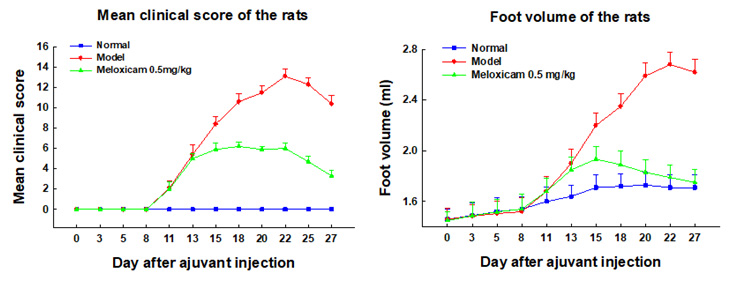


Rheumatoid arthritis (RA) is a systemic inflammatory disorder characterized by chronic inflammation of the synovium, which over time results in damage to the joints, leading to pain and disability. It occurs in approximately 1% of adults, and approximately 2.5 times more women than men are affected. Immune factors involved in the progression of RA are mainly produced by CD4+ T cells, monocytes, macrophages, or fibroblasts. Cytokines produced by these cells such as tumor necrosis factor α (TNF-α) and interleukin-1 are the keys to the damaging cascade that ultimately triggers the production of matrix metalloproteinases and osteoclasts resulting in irreversible damage to soft tissues and bones.
Understanding of molecular pathogenesis in RA has enabled development of novel therapies to modulate specific components of the disease pathway for early intervention or treatment. Various experimentally induced RA rodent models have been used extensively as the mainstay for evaluation of those therapeutic candidates.
·Symmetrical joint involvement, peripheral joints affected, persistent joint inflammation
·Synovial hyperplasia, inflammatory cell infiltration, marginal erosions
·Genetically regulated by MHC and non-MHC genes, responsive to most therapies effective in RA
·Female rats have greater disease susceptibility to streptococcal cell wall induced arthritis, while male mice are more susceptible to collagen-induced arthritis (CIA)
·Unlike other models, mouse CIA model is not responsive to non-steroidal anti-inflammatory drug
·Unlike human RA, anti-collagen responses are not present in many cases of rat CIA, and rheumatoid factor is not present in neither CIA nor streptococcal cell wall-induced arthritis in rats
·Bone mineral density (peripheral QCT), bone erosion, abnormal bone growth and joint space narrowing (X-rays, micro-CT)
·Antigen-specific T-cell and B-cell responses, cytokine and signal transduction levels, and cell function analysis (ELISA, RT-PCR, Western blot, flow cytometry)
Histomorphometry (bone destruction)
lmmunohistochemistry (cellular infiltration in joint tissue)
Aim: To examine the effect of meloxicam on adjuvant-induced arthritis in Lewis rats
Animal: Lewis Rats, male, 180-210g (used in experiment), Beijing Vital River Laboratory Animal Technology Co., Ltd.
Reagent: Mycobacterium tuberculosis H37Ra: Difco. Paraffin oil: Sinopharm Chemical Reagent Co., Ltd. Meloxicam: Boehringer-Ingelheim



With fully validated RA models and the state-of-art equipment, PharmaLegacy provides exceptional services for preclinical pharmacology studies of drug candidates for RA treatment, including:
·Evaluation of therapeutic profile and potentials of the candidate compounds
·Proof of concept for early drug development
·Demonstration of differential regulation of disease progression and clinical symptoms
·Examination of anti-autoimmune disorders as well as anti-inflammatory effect such as T cell and B cell response, and cytokine/chemokine response
·Investigation of the mechanisms of immune tolerance induction